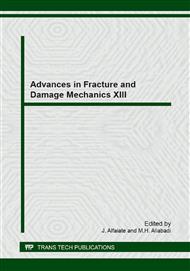p.161
p.165
p.169
p.173
p.177
p.181
p.185
p.189
p.193
Effect of Hot Water Environment on Tensile Fracture Properties of Carbon Fiber Reinforced Polyoxamide Composites
Abstract:
Matrices for carbon fiber reinforced thermoplastics are appropriate to use comparatively cheaper resins such as polyamide. However polyamide 6 is highly hygroscopic and the mechanical properties of materials are reported to be degraded by water absorption. Polyoxamide (PX) has been developed as polyamide resins with low hygroscopicity. In this study, the effect of hot water environment on the tensile fracture properties of carbon fiber/polyoxamide composites has been clarified.
Info:
Periodical:
Pages:
177-180
Citation:
Online since:
September 2014
Authors:
Keywords:
Price:
Сopyright:
© 2015 Trans Tech Publications Ltd. All Rights Reserved
Share:
Citation:


